- Home
- Timothy Egan
Breaking Blue Page 8
Breaking Blue Read online
Page 8
When Ralstin arrived back at Mother’s Kitchen, he looked edgy for the first time since the killing. Pearl Keogh saw a big, bold man who had lost his strut. Ralstin and Burch argued. Something had to be done with the gun: not the loaded .32 that had been found in the World Hotel—Ralstin knew that gun had no link to the bullets that ended the life of Marshal Conniff—but another gun, another .32-caliber revolver. A bullet leaves the barrel with exit marks unique to the gun from which it was fired; in that sense, it can be traced like a fingerprint. Ballistic experts try to determine which gun fired a particular bullet by examining the grooves inside the pistol. In the 1930s in Spokane, whenever a cop arrested somebody, he was entitled to take and keep the criminal’s weapon, one of many small perks. The officer had only to register the gun with the department, noting the serial number of his new possession. Clyde Ralstin had kept a .32 pistol from an arrest a few years earlier. It wasn’t his favorite gun; the piece was too small for his use—practically a toy, he used to say. But because of its size, it fit nicely in a holster inside his suit without causing so much as a ripple in his jacket. Now, if Logan broke down and told Sonnabend everything he knew, they would want to check Clyde’s .32, which he had left in the Stone Fortress. If the gun matched the bullets from Conniff’s body, and Logan told everything he knew about Clyde’s involvement, Ralstin would be the one facing a noose at Walla Walla.
Detective Ralstin’s solution was simple and direct: the .32 had to be buried. Now. But how to get rid of it was a bigger problem. The pistol was at the Stone Fortress, where Logan was under intense, round-the-clock questioning. Not to worry, Ralstin assured Burch. He had a lot of friends at the Stone Fortress.
“WHY ARE THE ITALIANS invading Ethiopia?” Pearl Keogh asked Ruth.
“The dictator, Mussolini,” her sister replied. “He’s hungry.” In the last week, the sisters had talked openly of everything except what they had seen and heard at Mother’s. So much had transpired in front of them that they were starting to feel like accomplices. Ralstin had been so confident of his control over all who sipped coffee and passed the time at Mother’s Kitchen that he had not bothered to be very discreet. The sisters from Montana had heard the whole thing—talk of the shooting, fretting over Logan’s arrest, the order to get rid of all the surplus butter and alert everybody who had some connection to the gang. They were ready to tell the police—a move that might cost Ruth her job. With her husband in the sanitarium and jobs scarce, Ruth would be left without a way to support her three children. How would she stay alive? Pearl had no money; the hospital paid her in scrip for her work as a nurse. Ruth feared that she might have to join the long line that stretched from the soup kitchen at Sacred Heart around the block and down the hill. Going to the police could mean her children would go hungry and she would lose what dignity her wages at Mother’s Kitchen had brought her.
Pearl and Ruth were Catholic, raised in the Jesuit tradition in Montana, but they weren’t lily-white by any means. Pearl liked to party and flirt, and she occasionally let her pride get the best of her. But no matter how many minor lapses there had been, she had tried to keep her soul free of the big sins—the ones that could anchor a spirit in hell. A mortal sin meant eternal damnation, if the offense wasn’t first wiped away by confession. The worst sin of all was to take another human’s life. And to know of such a crime and do nothing was no different than carrying that very stain on your soul. After a long night of discussion, which spilled over into another hot early-October dawn, the sisters decided it was better to risk hunger and have a clean conscience than to keep quiet and hold on to a job in a place run by men who seemed at times to be the devil’s soldiers.
So, they would go to the authorities and tell them everything. Their evidence consisted of what they had heard and what they had found. “We’ve got proof,” Pearl told her sister by way of shoring up a tenuous decision. “And we owe it to that marshal’s family.”
They thought first of going to the Spokane police, but Ralstin and his close associates at Mother’s Kitchen were the Spokane police; they might as well call up Clyde and say they were about to turn him in. Pearl couldn’t shake the image of Detective Ralstin and his routine with Virgil Burch: the strut, the smirk, the line “Who’d you kill today?” What about the sheriff from Pend Oreille County, Elmer Black? It was his jurisdiction. No, Pearl said; he was too close to the Spokane police. Every time the papers mentioned something about the Conniff investigation, it was always Black working with Spokane detectives.
They decided to go to the Spokane County sheriff, Ralph Buckley. His men seemed to be clean. When Ralph Foley, the prosecutor, had raided the Chinese gambling and opium dens earlier that year, he had used county cops.
Sheriff Buckley listened to everything Pearl and Ruth told him about the goings-on at Mother’s Kitchen. He acted very interested, jotting down notes and names, nodding and encouraging. After an hour or so, Buckley showed them out the door, and said they should not breathe a word of this to another soul. The sisters had thought of going to the FBI, or maybe directly to the prosecutor, but Buckley assured them such steps weren’t necessary. They had done the right thing. He would personally take control of everything they had told him. One last thing: he asked if they were sure about this big fellow, Detective Clyde Ralstin. Oh yes, the sisters answered. Clyde’s the one. When Pearl started to describe him in detail, Buckley cut her off. He knew Detective Ralstin.
ON HIS THIRD NIGHT in custody, Acie Logan was hungry, tired, and angered at the absence of Clyde Ralstin. He had not told Detective Sonnabend anything about the killing or the Newport Creamery robbery. But he was feeling betrayed. Chain-smoking, he went back and forth with the big cop about what he knew and didn’t know. As they spoke, Sonnabend assured him that the entire operation—the black-market butter schemes, the fencing of shoes and bacon—was about to collapse. Other cops were out in the field, rounding up members of the gang.
“You will hang, Acie,” Sonnabend told him.
Better to tell the detective everything. Cut a deal. Maybe Logan could still keep his long neck out of a noose at Walla Walla.
Exhausted, Logan fell asleep, slumped against the wall on the sixth floor of the Stone Fortress. His partner Spinks was good for very little. Sonnabend told the papers that Logan was the one with knowledge.
From the top floor of the Stone Fortress, the Spokane River looked like a black snake, slipping around the big rocks just below the falls. The water that pushed through the ancient channel was tired. If the river could hold its flow through this drought, make it till the November rains, things might return to normal. The woods still smoldered, and some said only winter snow could snuff the big fires. Further downstream, beyond the point where the Spokane fed the Columbia, engineers were blasting through basalt, looking for places to anchor the foundation of the Grand Coulee Dam. When the Columbia was finally harnessed, the water would back up for hundreds of miles, burying centuries of human life and bringing green to the high desert. Then, the parched inland Northwest would have all the water it ever needed, no matter what the capricious moods of fire or weather. Man would control water, the master architect of the Northwest.
The first light bled out of the eastern sky, and a flutter of color lit the thin falls of the river. Logan was asleep, fresh bruises on his dirty face. A new day, and the police were so close. Detective Sonnabend, the carpenter cop, felt the foundation of this case was in place, the house was framed, and they might very well top it today.
A reporter knocked on the detective’s door, loaded with coffee and questions. A familiar face around the Stone Fortress, the newsman asked Sonnabend about the Conniff case.
“It will be solved within twenty-four hours,” he replied, and the reporter thanked him for the headline.
8.
To the River
THE POST STREET BRIDGE spans the midsection of Spokane Falls, where the water gathers after tumbling over one of three drops. From the bridge, the torrent looks impossible to descend
by canoe, kayak, or raft; yet people have thrown themselves into the swirl in an act of bravado—or a moment of despair. As the water slides through the rock cliffs, en route to the Columbia and the Pacific, the river powers turbines that light the streetlights of Spokane. A few years after the city was incorporated, in 1881, the river brought light to downtown streets; it was one of the first waterways in the world to be harnessed for electricity. During the mid-1930s, when Spokane had to close its zoo and pawn the animals, electric power—even that which came from the perpetual flow of the falls—was considered a luxury, and so the city removed nearly four hundred streetlights, and much of Spokane was dark at night.
The police station was a long block south of the Post Street Bridge. The span was a place for private talks and solitary strolls. At peak flow, the roar of the falls was so loud that two people could not hear themselves speak. But in early October, when the surface of the land was hard and dry, and little water fed the falls, the sound was a weak cry in the background of a clattering city, dominant only when Spokane slept.
In the darkness of night, Dan Mangan and Bill Parsons stood above the falls on the bridge. Their police car, a Pontiac with a radio inside, one of five patrol cars used on each shift, idled as Mangan stepped out. They were both in uniform, on duty, upholding the laws of the city of Spokane. Mangan was carrying a package, a bundle of newspapers wrapped around a gun. Parsons was confused. The rookie, still on probation, was paired with Mangan that night because Dan’s regular partner was off. Parsons was still trying to make a name for himself as a decent policeman. On a recent night, while Officer Mangan had been breaking into a restaurant called Dorothy’s and stealing what he could get from inside the diner, Officer Parsons had recovered a stolen typewriter, and he was written up in the newspaper for this notable bit of police work.
Mangan usually operated on the other side of the law, and ’most everybody at the Stone Fortress knew what he was up to. When a particularly dirty job had to be done, Mangan was summoned. It was that reputation that led to his arrival on the ledge of the Post Street Bridge, carrying a package. In addition to burglaries, break-ins, and shakedowns, Officer Mangan drew a regular income from bootleggers, who delivered his payoff in envelopes—usually ten dollars at a time, but sometimes more. Although Mangan was constantly reprimanded, he was never seriously disciplined. His personnel file was stuffed with suspension and warning notices for actions labeled “disgraceful” and “conduct unbecoming an officer.”
Mangan would show up in the cold house he kept in the east part of town drunk and smelling of perfume; if his wife, Helen, ventured to raise even the weakest line of questioning, he would knock her to the ground or put his fist to her face. Often, she was kicked around in front of her children, who were jolted awake by the noise of the drunken patrolman returning from a binge. The next day, nursing a black eye or a swollen lip, Helen Mangan felt helpless. And when friends would seek to console her, she would wonder aloud, “What am I supposed to do—call the police?” Because he considered himself a good Catholic, Mangan would not allow his wife to divorce him.
Mangan’s regular partner was Hacker Cox. Cox had picked up his nickname because of his habit of hacking at prisoners in the elevator on the way up to jail. On the short ride from the ground floor of the Stone Fortress to the top-floor jail, Hacker Cox could change a man’s appearance.
Cox and Mangan were perfect for each other; they also occupied regular stool space at Mother’s Kitchen and aspired to be in the close orbit of Detective Ralstin. In early October they were given their chance. Just after Sonnabend announced that the killing of Marshal Conniff would be solved within twenty-four hours, Mangan was called in to see Captain James “Ed” Hinton, one of three shift leaders in the Spokane Police Department. Fat-faced and balding, with deep circles under his eyes and cheeks shaped by an habitual scowl, Hinton moved in a slightly higher circle than Ralstin or Mangan, spending late hours at the finer speakeasies in the company of the city’s other mid-level leaders. Early in 1935, which had opened with the Spokane Chronicle’s call for a full inquiry into corruption at the Stone Fortress, there came rumblings of a grand jury investigation of the department. As soon as Captain Hinton heard about the prosecutor’s action, he fled to Canada. He later reappeared, back as the shift captain, when the legal thunder died down. Hinton wanted to be chief, and it was that career goal which kept him on a leash held by Clyde Ralstin. Clyde would not have minded seeing Hinton as the top man of the largest police department between Minneapolis and Seattle.
When Captain Hinton called Mangan into his office, he did not look the patrolman in the eyes.
“Shut the door,” he said.
“What’s up?”
“Ralstin’s in trouble,” the captain said. “He needs a favor.”
“What kind of trouble?”
“Cox will tell you.”
“He’s off today.”
“I know he’s off. Go to his house. He’s got something for you. Who’s your partner today?”
“Bill Parsons.”
“Take him.”
“You sure about Parsons?”
“Take him. He’s okay now.”
Mangan and Parsons drove to the northwest part of town, to the home of Hacker Cox. Mangan was silent most of the way. When he pulled up in front of the house, he kept the engine running. He returned in a minute with a package wrapped in newspaper.
“What’s that?” Parsons asked.
“A favor.”
“What kind of favor?”
“Ralstin’s in trouble. We gotta get rid of this.”
Mangan turned the Spokane police car around and headed south, for the river. He did not say a word during the drive.
WHEN DETECTIVE SONNABEND went to round up the other members of the butter gang, he discovered that most of them had left town. The loot also was gone. Shoes, bacon, butter—it had disappeared. How could this be? They had Logan and Spinks in custody, and they knew about most of the operation, where the butter had come from. Sonnabend was livid; almost overnight, his case was falling apart. How could he get a conviction without the evidence?
Back at the Stone Fortress, a young officer approached him, somebody who had been in Mother’s Kitchen a few days earlier. He took Sonnabend aside and told him that everybody involved in the black-market ring had been tipped off by Clyde Ralstin.
“Ralstin? Detective Ralstin?”
The detective had leaked the latest information from the Stone Fortress to his partners in the fence—his partners? That’s right, the officer said. And Ralstin was their leader.
Sonnabend had heard plenty of stories about his fellow detective. Most of them, he couldn’t give a damn about; but this was a new low. Not only was Ralstin sabotaging a murder investigation; he might have had a hand in the killing.
Sonnabend stormed into the office of Ira Martin, chief of police. Martin, the first chief to hold the job for any considerable amount of time, was particularly good at curbing public outrage during the periodic calls for wholesale firings and grand jury investigations. He was known as an efficient administrator, not particularly cunning or well connected around town. Above all, he believed in the institution; after a tumultuous decade of graft, and then five years of hard times, the very survival of the police department was at stake.
When Sonnabend told him that Detective Ralstin had leaked inside information to the very criminals who were under investigation, Martin at first tried to calm him. Sonnabend’s face went red, and he waved his callused hands around. Whose side were they on, for Christ’s sake? Ralstin had sabotaged his case! He should be arrested—prosecuted! Fired at least!
The chief was well aware of the complaints about Ralstin. This latest information did not seem to surprise him so much as it left him looking helpless. He couldn’t bring the hammer down on Detective Ralstin because it would damage the entire department at a time when it was under siege from the newspapers, the federal prosecutor, the county. And Ralstin could do more tha
n seriously tar the reputation of the Spokane Police Department. If cornered, he could end careers, force men into jail, break up families. Is that what Sonnabend really wanted—to ruin the lives of other policemen?
AT THE Post Street Bridge, high above the falls, Officer Mangan opened the door of his police vehicle and walked to the rail. The Great Northern Railroad clock tower, an Italian Renaissance-styled spire, was anchored to the riverbank, a place where saw and grist mills used to crank out the elemental products of the infant town. The biggest Hooverville was not far from the railroad tower, upriver, and the little squatters’ camp at the base of the falls was less than a mile the other direction, downstream. In accordance with the wishes of Spokane’s political and business leaders, the smaller homeless village would soon be doused with gasoline and burned to the ground. Upriver another twenty miles or so was the graveyard of the eight hundred horses slaughtered in 1858 by Colonel George Wright. Some of the bodies had floated down the river. But a number of skeletons, the bones bleached white by the sun and then decayed to an overcast gray, had remained in clumps at the site of the mass shooting. It became known as Horse Slaughter Camp, a designation that Spokane’s promoters tried to discourage; Wright’s animal massacre was not a historical image that merited further scrutiny. By the early part of this century, most of the bones had been reduced to ash and had washed downstream, the river hiding the last physical traces of the mass killing. Only the memories of cavalry soldiers, preserved in diaries describing the “whinnying cries” of the panicky animals, remained as proof of the night Colonel Wright executed eight hundred horses.
Long ago, in other days of early October, nearly ten thousand natives used to gather to spear fish and talk trade and swap products at the base of Spokane Falls. The original Spokane people believed that a benevolent god had created this breach to funnel fish into the hands of the hungry. When most of the natives and the fish runs had died, and the new city rising around the falls wanted to distinguish itself, civic leaders hired the Olmsted Brothers, the landscaping firm from Brookline, Massachusetts, to create something of lasting value in Spokane. The brothers, whose father had helped design New York’s Central Park, said the city needed only to protect and highlight the great natural waterfall in its midst. “Nothing is so firmly impressed on the mind of the visitor to Spokane as the great gorge into which the river falls near the center of the city,” the brothers wrote.

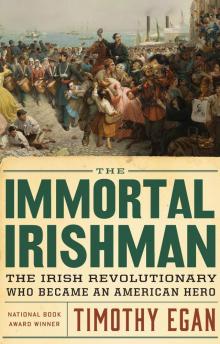 The Immortal Irishman
The Immortal Irishman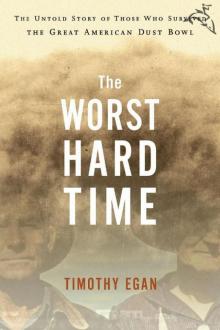 The Worst Hard Time: The Untold Story of Those Who Survived the Great American Dust Bowl
The Worst Hard Time: The Untold Story of Those Who Survived the Great American Dust Bowl The Good Rain: Across Time & Terrain in the Pacific Northwest
The Good Rain: Across Time & Terrain in the Pacific Northwest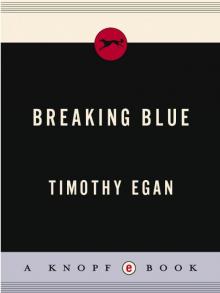 Breaking Blue
Breaking Blue Lasso the Wind: Away to the New West
Lasso the Wind: Away to the New West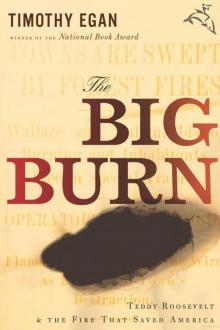 The Big Burn: Teddy Roosevelt and the Fire That Saved America
The Big Burn: Teddy Roosevelt and the Fire That Saved America Short Nights of the Shadow Catcher
Short Nights of the Shadow Catcher A Pilgrimage to Eternity
A Pilgrimage to Eternity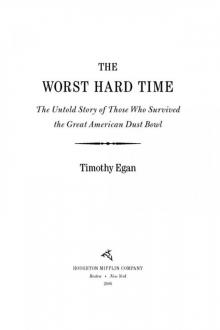 The Worst Hard Time
The Worst Hard Time The Big Burn
The Big Burn